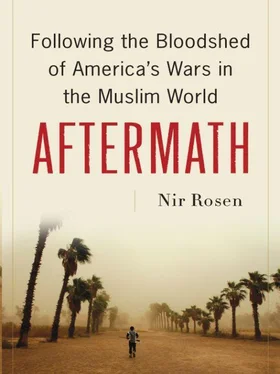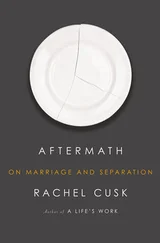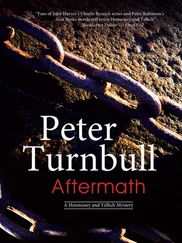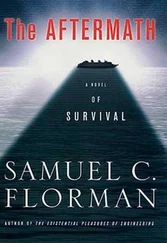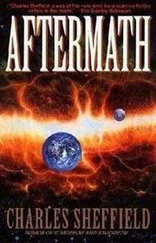As the streets of Ur and Shaab filled with thousands of men indolently strolling home in the heat or heading to minibuses and trucks to depart, across town, in the western neighborhood of Ghazaliya, prayer was also ending, and several hundred Sunni men were leaving the Um Al Qura Mosque, which had once been so central to the resistance. It had once been a symbol of Sunni domination; now it was a symbol of vulnerability and fear. Gruesome posters lined the mosque’s walls, depicting slain members of the Association and other murdered Sunnis. “Our martyrs are twinkling stars in the Iraqi sky,” said one, while others showing dead bodies demanded “yes to the state of law,” “no to organized government terrorism,” “no to endless sinning,” and lamented what they described as a “massacre of freedom,” and “massacre of seven innocent men.” I was stunned by the shift in tone.
A few days later, on April 4, 2006, I was back at the Um Al Qura Mosque, waiting in the sun after a friend who moonlighted for the Association of Muslim Scholars told me the bodies of Sunnis slain in sectarian violence were coming from the morgue. In front of the Um Al Qura Mosque, Iraqi National Guardsmen manned their machine guns on a pickup truck. Ghazaliya had long been one of Baghdad’s main no-go zones for foreigners, journalists, and even many Iraqis. When American or Iraqi army or police forces were not looking, Sunni militias openly patrolled its streets and stopped cars at checkpoints to look for suspicious outsiders. Shiites living in Ghazaliya had been receiving death threats, if they were lucky, warning them to leave the neighborhood. As I stood in the parking lot with a few Iraqi cameramen working for local and international media, I could hear exchanges of fire in the distance; later I saw American Humvees and Iraqi police in pickup trucks circling the mosque.
Finally we heard the sounds of wailing coming from the mosque’s gate. Two trucks accompanied by men on foot made their way to the mosque. The men were crying and beating themselves, stopping to collapse on the ground or raise their arms in desperation, then shouting, “There is no god but Allah!” Their screams competing with one another, they cursed the killers. “Faggots!” “Brothers of whores!” they shouted. “This is a disaster! What did they do?”
“We are almost extinct! They broke our backs!” “The pimps! The bastards! The infidels!” I asked one of the men to tell me what had happened. “They took them in the south from their shops. They took them to an office, and then they took their car. We found them yesterday in the fridge in the morgue. They live in Ghazaliya. Four brothers. And two were father and son!” he began crying again.
An older man wearing tribal clothes and hiding his face with his head scarf shouted, “This is an Iranian wave, arranged by Iran. We are Muslims, and this is our country. Why are they doing this to us? And they are saying, ‘We are the Mahdi Army.’ Did the Mahdi tell them to do that? One of them is only twelve years old!” He explained that the dead were Sunni shopkeepers. “They took them to Kut, and they executed them. In the Jihad district they killed fifty-seven people. They arrested them and executed them. Everywhere they kill Sunnis.” He added that when relatives came to pick up their bodies from the morgue, they too were kidnapped.
The trucks stopped at the mosque’s steps. The rugs were removed from on top of them, and the wooden coffins were placed on the ground, their covers pulled to the side, revealing bodies hidden by plastic. “Open the bags so they can see,” one man said. “This one is only ten years old,” cried a man. “They killed him by strangling. This is a kid. Should he be strangled? Look at him. Open the bag, let them see!” The boy did indeed look about ten, his face swollen and eyes closed, thick stitches lining his chest.
They opened another coffin. “This one was tortured before killing!” one man shouted. “Look at his teeth. They pulled out his teeth! He was helping his father. Why did they do that to him? Is it only because they are Sunnis?” he raised his hands up and shouted, “ Allahu akbar! ” (God is great!) I looked at the corpse’s bruised face: a middle-aged man missing some of his front teeth. “God curse the oppressors!” the mourners shouted, embracing the coffins and corpses. “Even Jews wouldn’t do this!” shouted one man. “They say that Saddam Hussein was a tyrant, so how do you explain this?”
Then somebody decided the show was over. The coffins were placed on the trucks and driven away, followed by the Iraqi journalists. Members of the AMS remained outside, discussing a Sunni man who had gone to visit his relatives in the hospital but was kidnapped by six men. “They control the hospitals,” said one man, referring to Muqtada’s followers. He noticed me filming him and angrily covered the lens with his hand. I was later told that he was head of security for the AMS.
On my way back I drove through the wealthy Mansour district, where I had lived briefly in my first months in Iraq. Two bodies were lying dead on the main street. It was a normal sight. I later found out they had been Iraqi staff of the embassy of the United Arab Emirates. That day a Sunni friend from Amriya called me distraught because his Shiite neighbor and friend had been killed the previous night. It was normal. At least ten bodies were found in Amriya that day. A Sunni man who picked up one of them to bring him to the hospital was also killed, for doing just that. On a different day a friend from Amriya told me that two cars pulled up in front of a Shiite home and riddled it with machine-gun fire. On another typical night, Shiites in a Sunni neighborhood saw masked men in their garden. They found a letter ordering them to leave. The following day they did. One day a friend from Amriya was delayed meeting me because seven bodies had been found on his street.
Three days later I was on the road to Najaf from Baghdad, a key pilgrimage route for Iraq’s Shiites. It was fraught with the unique new dangers of the country’s civil war. I drove down with Shiite pilgrims, aware that the day before a minibus much like mine carrying Shiites had been sprayed with machine-gun fire from two cars in the Sunni town of Iskandariya, about twenty-five miles south of Baghdad. Five of the pilgrims had been killed. My companions were a young man called Ahmed, his mother, and their friend Iskander, who was the driver. They hailed from Sadr City, and we were going to see Muqtada speak in the Kufa Mosque, outside Najaf.
Numerous Iraqi police and Iraqi National Guard checkpoints slowed our progress. At each stop the policemen would peer through the driver’s window and ask where we were going. “We’re a family from Sadr City,” Iskander would say, or sometimes just “from the city,” since the men would know what he meant. “We’re going to Najaf.” We would be waved along with a smile: “Go in peace.” We drove past brick factories and palm groves, and as we approached Najaf we were stopped more and more often, our minibus searched, our bodies patted down. Finally all roads were closed off to vehicles. Our minibus was parked on a sandy lot with hundreds of others. Some had wooden coffins lashed on top. They were to be buried in the City of Peace, the vast cemetery for Shiites who seek to lie close to Imam Ali in Najaf. ING men waved metal detectors over all visitors. The day before, there had been a massive car bomb on this very road. Men waited with pushcarts to carry the feeble, or load as many shrouded women as possible, or carry coffins. Other coffins were carried on relatives’ backs in long processions sometimes led by clerics. We walked past three minibuses that had been crushed and blackened by the previous day’s explosion and one car that had flipped over. ING men in blue fatigues surrounded the charred wreckage and beseeched the many pilgrims who stopped to stare in silent wonder, “Please, brothers, move on.”
Читать дальше
